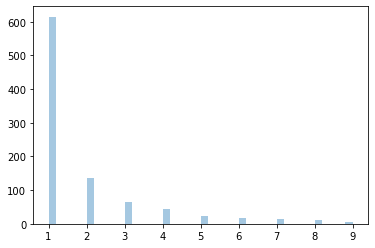W3schools - Python_Numpy Random
찾으시는 정보가 있으시다면
주제별reference를 이용하시거나
우측 상단에 있는 검색기능을 이용해주세요
Numpy Random
Random number doesn’t mean a different number every time
Random means something that can’t be predicted logically
Pseudo Random
Programs are definitive set of instructions
It means there must be some algorithm to generate a random number as well
Thus it is not truly random, is called pseudo random
True Random
In order to generate a truly random number on our computers we need to get the random data from some outside source
- Is generally our keystrokes, mouse movements, data on network etc.
from numpy import random
a = random.randint(100) # output random integer from 0 to 100
b = random.rand() # output random float from 0 to 1
c = random.randint(100, size=(5)) # output 1-D array containing 5 random integers from 0 to 100
d = random.randint(100, size=(3,5)) # output 2-D array containing 3*5 random integers from 0 to 100
e = random.rand(3,5) # output 2-D array containing 3*5 random float from 0 to 1
arr = [1,2,3,4,5]
f = random.choice(arr) # output Random value based on an array of values
g = random.choice(arr, size=(3,5)) # output 3*5 Random value based on an array of values
# To specify the probability for each value
h = random.choice(arr, p=[0.1, 0.3, 0.4, 0.2, 0.0]) # output random integers based on an array of values, the value 5 will never occur
Permutation
from numpy import random
import numpy as np
arr = np.array([1,2,3,4,5])
# Changing arrangement of elements in-place
random.shuffle(arr)
print(arr)
# Returns a re-arranged array(and leaves the original array un-changed)
print(random.permutation(arr))
Seaborn
Is a libarary that uses Matplotlib underneath to plot graphs
- It will be used to visualize random distributions
distplots
- It stands for distribution plot, it takes as input an array and plots a curve corresponding to the distribution of points in the array
Distribution
Normal
Is called the Gaussian Distribution
It has 3 parameters
-
loc : Mean, where the peak of the bell exits
-
scale : Standard deviation, how flat the graph distribution should be
-
size : The shape of the returned array
The curve of a normal distribution is also known as the Bell Curve because of the bell-shaped curve
from numpy import random
import matplotlib.pyplot as plt
import seaborn as sns
sns.distplot(random.normal(size=1000), hist=False)
plt.show()

Binomial
Is a Discrete Distribution
It describes the outcome of binary scenarios
It has 3 parameters
-
n : number of trials
-
p : probability of occurrence of each trial(e.g. for toss of a coin 0.5 each)
-
size : The shape of the returned array
from numpy import random
import matplotlib.pyplot as plt
import seaborn as sns
sns.distplot(random.normal(loc=50, scale=5, size=1000), hist=False, label= ‘normal’)
sns.distplot(random.binomial(n=100,p=0.5,size=1000), hist=False, label= ‘binomial’)
plt.show()

Difference between Normal and Binomial Distribution
- Main difference is that normal distribution is continuous whereas binomial is discrete, but if there are enough data points it will be quite similar to normal distribution with certain loc and scale
Poisson
Is a Discrete Distribution
It estimates how many times an event can happen in a specified time
It has 2 parameters
-
lam : rate or known number of occurrences e.g. 2 for above problem
-
size : the shape of the returned array
from numpy import random
import matplotlib.pyplot as plt
import seaborn as sns
sns.distplot(random.normal(loc=50, scale=7, size=1000), hist=False, label= ‘normal’)
sns.distplot(random.poisson(lam=50, size=1000), hist=False, label= ‘poisson’)
sns.distplot(random.binomial(n=1000, p=0.05, size=1000), hist=False, label= ‘binomial’)
plt.show()

Difference Between Normal and Poisson Distribution
- Normal distribution is continuous whereas poisson is discrete
Differnece Between Poisson and Binomial Distribution
-
Is very subtle it is that, binomial distribution is for discrete trials, whereas poisson distribution is for continuous trials
-
But for very large
nand near-zeropbinomial is near identical to poisson such thatn*pis nearly equal tolam
Uniform
Used to describe probability where every event has equal chances of occurring
It has 3 parameters
-
a : lower bound, default 0
-
b : upper bound, default 1
-
size : the shape of the returned array
from numpy import random
import matplotlib.pyplot as plt
import seaborn as sns
sns.distplot(random.uniform(size=1000), hist=False)
plt.show()
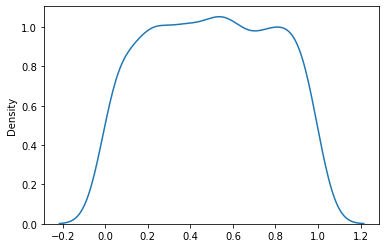
Logistic
Is used to describe growth
Used extensively in machine learning in logistic regression, neural networks etc.
It has 3 parameters
-
loc : mean, where the peak is, default 0
-
scale : standard deviation, the flatness of distribution, default 1
-
size : the shape of the returned array
from numpy import random
import matplotlib.pyplot as plt
import seaborn as sns
sns.distplot(random.logistic(size=1000),hist=False)
plt.show()
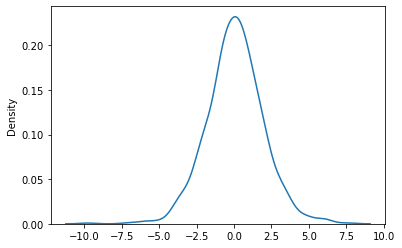
Difference Between Logistic and Normal Distribution
-
Both are near identical, but logistic has more area under the tails
-
It representage more possibility of occurrence of an events further away from mean
Multinomial
Is a generalization of binomial distribution
It describes outcomes of multi-nomial scenarios unlike binomial where scenarios must be only one of two
It has 3 parameters
-
n : number of possible outcomes
-
pvals : list of probabilities of outcomes
-
size : the shape of the returned array
from numpy import random
x = random.multinomial(n=6,pvals=[1/6,1/6,1/6,1/6,1/6,1/6])
As they are generalization of binomial distribution their visual representation and similarity of normal distribution is same as that of multiple binomial distributions
Exponential
Is used for describing time till next event
It has 2 parameters
-
scale : inverse of rate, default 1
-
size : the shape of the returned array
from numpy import random
import matplotlib.pyplot as plt
import seaborn as sns
sns.distplot(random.exponential(size=1000), hist=False)
plt.show()
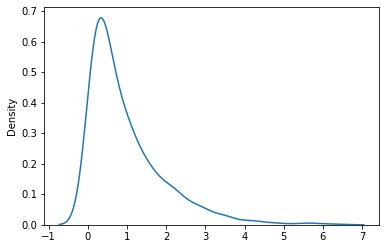
Relation Between Poisson and Exponential
- Poisson distribution deals with number of occurences of an event in a time period whereas exponential deals with the time between these events
Chi Square
Is used as a basis to verify the hypothesis
Is has 2 parameters
-
df : degree of freedom
-
size : the shape of the returned array
from numpy import random
import matplotlib.pyplot as plt
import seaborn as sns
sns.distplot(random.chisquare(df=1,size=1000),hist=False)
plt.show()
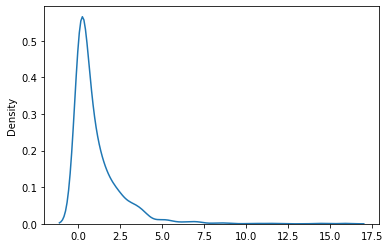
Rayleigh
Is used in signal processing
It has two parameters
-
scale : decides how flat the distribution will be default 1
-
size : the shape of the returned array
from numpy import random
import matplotlib.pyplot as plt
import seaborn as sns
sns.distplot(random.rayleigh(size=1000),hist=False)
plt.show()
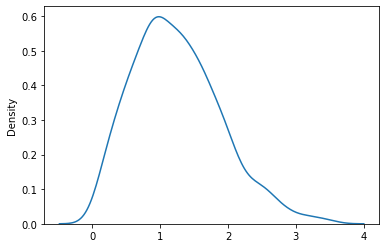
Similar Between Rayleigh and Chi Square Distribution
- At unit stddev the and 2 degrees of freedom Rayleigh and chi square represent the same distributions
Pareto
80 - 20 distribution (20% factors cause 80% outcome)
It has 2 parameters
-
a : shape parameter
-
size : the shape of the returned array
from numpy import random
import matplotlib.pyplot as plt
import seaborn as sns
sns.distplot(random.pareto(a=2, size=1000),kde=False)
plt.show()
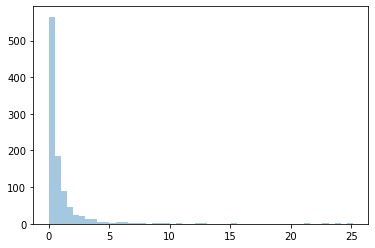
Zipf
Are used to sample data based on zipf’s law
- Zipf’s law : In a collection the nth common term is 1/n times of the most common term
It has 2 parameters
-
a : distribution parameter
-
size : the shape of the returned array
from numpy import random
import matplotlib.pyplot as plt
import seaborn as sns
x = random.zipf(a=2, size=1000)
sns.distplot(x[x<10], kde=False)
plt.show()
